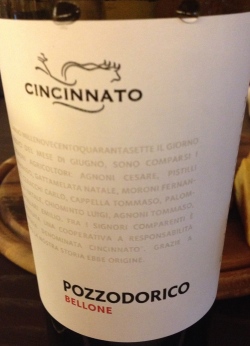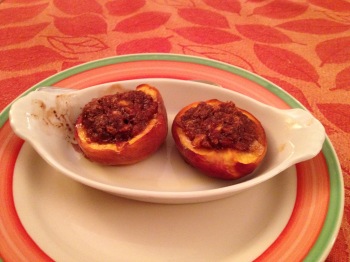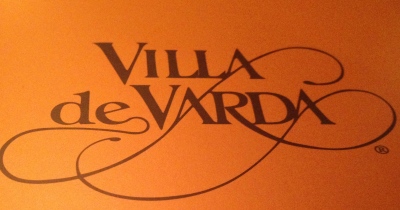I like grappa. I often drink it after a meal as a way to relax and to help me to digest. Sometimes I put a little in my espresso, for what Italians call caffè corretto. I drizzle grappa on my lemon granita and other ices and pour it over fruit salad and cake.
Michele often cooks with grappa. A number of years ago Michele and I wrote an article for Gourmet Magazine called “Cooking with Grappa.” Grappa with chocolate is a great combination. The grappa chocolate cake appeared on the cover of the magazine along with a citrus fruit salad. She also included recipes for quails with grappa, pasta with shrimp and grappa, and so on.
Last year we were invited to participate in a choice of two grappa press trips organized by Hello Grappa. On tour A we would visit two distilleries and on tour B there were seven distilleries. Because of our schedule we could only go on tour A. We visited one distillery in Tuscany and one in Piedmont. It was a wonderful trip, very well organized, and we enjoyed tasting, drinking and learning about grappa. You can read more about it at Hello Grappa
This year we participated in Tour B and we visited 6 distilleries:
Umberto Bonollo – Conselve and Mestrino (Trento) Bottega – Bibano di Godega (Veneto)
Bepi Tosolini – Udine (Friuli Venezia Giulia) Castagner -Treviso (Trento)
Marzadre – Nogaredo (Trento) Bertagnolli – Mezzocorona (Trento)
These are all family run distilleries, some going back as far as 4 generations. As part of an effort to introduce grappa to a new audience, the producers on this tour emphasized aged grappa and grappa cocktails. In this article I will talk about the grappa cocktails that we sampled.
At lunch in Padua with Elvio Bonollo from the Bonollo distillery we tried a couple of aperitifs made with grappa Gra’it.
This is a clear grappa aged in large Slavonian oak casks with just a hint of the wood. It was especially made for mixed drinks and was a “lighter style grappa,” we were told. It is made from the skins of seven different grapes: Prosecco (Glera), Moscato d’Asti, Nebbiolo (Barolo), Nero d Avola, Corvina (Amarone), Sangiovese (Brunello) and Aglianco (Taurasi.
Elvio Bonollo said they chose the 7 best varieties to produce this grappa and unite them into one perfect blend.
GRA’IT & TONIC
30 ML/ 1 OZ Gra’it
90 ml/3 OZ Tonic Water
Garnish: fresh thyme
Method:
Fill the glass with ice. Add the Gra’it Grappa
and the tonic. Stir and garnish with fresh thyme before serving.
PINK PANTHER:
30 ML/ 1 OZ Gra’it
90 ml/3 OZ Pink Grapefruit Soda
Garnish: Pink Grapefruit Peel
Method:
Fill the glass with ice
Add the Gra’it Grappa followed by the
Pink Grapefruit Soda
Stir and garnish with grapefruit peels before serving
We enjoyed these before lunch on a warm day sitting outside in a picturesque square in Padua–Perfect!
At the Castagner distillery Giulia Castagner the daughter of the owner Roberto Castagner made us a cocktail to taste using their Casta Grappa. This grappa is made from 85% Glera grapes, which are white grapes used to make Prosecco, and it is 40 proof. Giulia said the grappa is distilled 5 times to insure purity and is specially formulated for cocktails.
Giulia also said that the grappa they send to the US is much lighter and smoother than the ones they sell in Italy.
TWIST DI NEGRONI
1/3 Casta
1/3 sweet vermouth
1/3 Campari
twist of lemon peel
Method:
Combine the ingredients over ice and stir.
One evening before dinner we went to the town of Conlgliano to taste cocktails made with grappa at a popular wine bar called DRY made with Alexander Prosecco Grappa by Bottega, which also produces Bottega Gold Prosecco DOC. 
MEDITERRANEO
90 ml Bottega Gold Prosecco DOC
90 ml Alexander Prosecco Grappa
4 orange slices
4 lemon slices
15 grams brown sugar
Basil Leaves
Ice cubes
Muddle brown sugar, 3 lemon and 3 orange slices and 4 basil leaves in a glass. Add the Alexander Prosecco Grappa and stir well.
Add ice and Bottega Gold Prosecco DOC and stir. Garnish with remaining lemon and orange slices and a sprig of basil.
GRAPPA SOUR
30 ml Alexander Prosecco Grappa
20 ml lemon juice
20 ml sugar syrup
Shake all ingredients in a cocktail shaker with ice. Strain into a chilled cocktail glass.
Alexander Grappa Prosecco is made from the skins of the Glera grape. The grappa is produced during three distillation phases with different temperatures in traditional copper alembics – bain-marie –with indirect heating. The grappa is remains is steel tanks for almost 6 months before it is bottled. This is a grappa that can be enjoyed by itself in small sips.
ZEN
Created and prepared by bartender Paolo Baldan
In a glass, blend 10 drops of ginger tincture with 1,5 oz of Alexander Grappa di Prosecco. Top with Cordial Lime, stir and serve.
Which was my favorite? For me, the choice is easy. I like a simple Grappa and Orange Juice:
Combine fresh orange juice with 2 to 3 ounces of grappa in a tall glass. Do not add ice. Great way to start the day!
At the Bepi Tosolini we tasted “Grappa Smoked.” Lisa Tosolini, granddaughter of the owner, told us that this grappa is distilled by the traditional method with bain marie pot still. This grappa is made from Friulian red grape skins and then aged in French oak barriques. The oak casks have gone through a toasting process with Kentucky tobacco leaves. This is a dry and intense smoked grappa which tasted like an aged single malt whiskey. This was a first for me and another new twist to what is being done with grappa.




















































